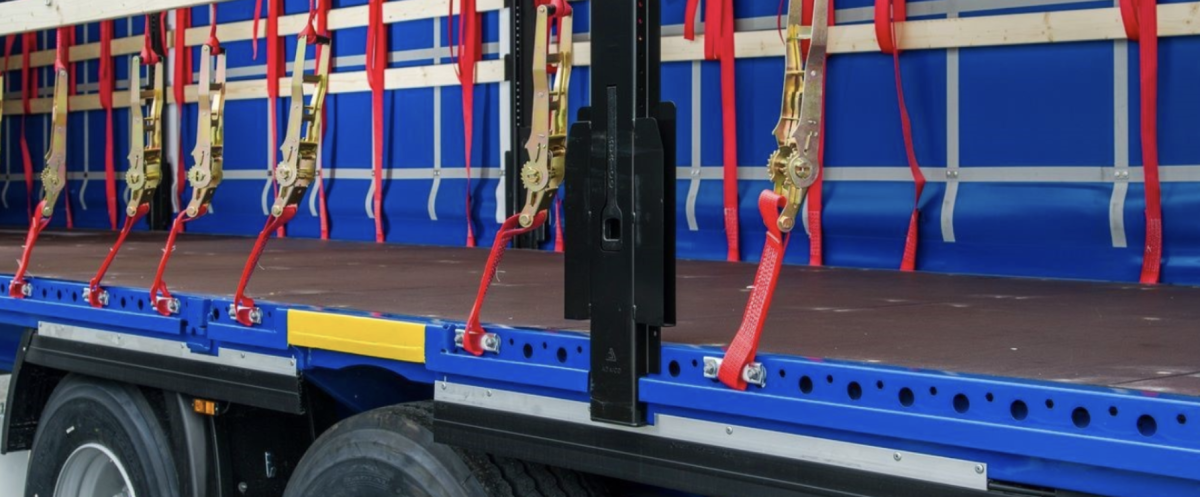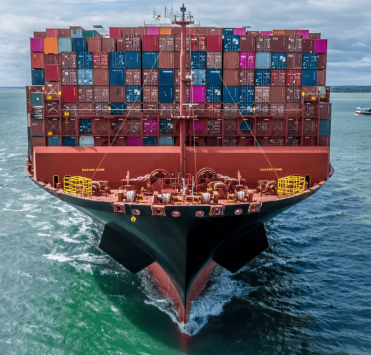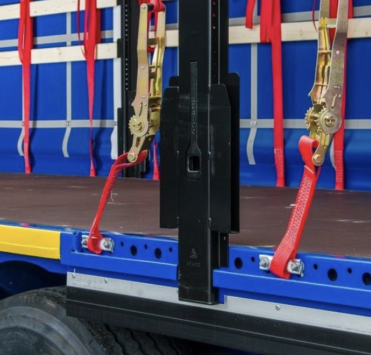Cargo securing: how and what to use to secure cargo during transportation

When transporting goods by road, it is important to strictly comply with established rules. The integrity of the cargo and the safety of all road users depend on the responsibility and professionalism of logistics companies.
To minimize risks, it is necessary to correctly place and securely fasten the cargo in the body of the vehicle. There are special requirements that ensure reliable fastening in a semi-trailer. Compliance with these requirements allows you to properly secure the cargo, preventing damage during the entire route.
Cargo transportation requires the use of various technical and organizational solutions. The main task is to securely fasten the cargo in accordance with established standards, which ensures its safety and security during transportation. Violation of the rules for loading or fastening can lead to the cargo falling or tipping over, creating a risk of accidents on the road.
Methods of securing cargo
1) Securing cargo by pressing is a method of fastening based on increasing the friction between the cargo and the vehicle platform. Adjustable straps and anti-slip mats are used for this purpose. The essence of the method is that tension straps are thrown over the cargo placed on the platform and secured to the sides of the body. Despite its widespread use, this method is not considered the primary one, as it does not provide a sufficient level of safety and requires a large number of straps to create even minimal pressure.
2) The method of securing cargo with tension straps involves the use of strong elements such as straps, chains, cables, or wire. This method prevents the cargo from shifting and tipping over during transport. Unlike the pressure method, it requires fewer straps but places higher demands on their strength and reliability. The straps are secured to metal brackets, which ensures a rigid fixation and high safety. As a rule, four straps are used, secured at the corners of the cargo, and a corresponding number of attachment points.
3) Cargo securing by blocking - this method of fixation is based on the use of the shape of the cargo and close contact with the surface. To prevent items from shifting, they are placed close to the rigid walls of the body, voids are filled, or shock-absorbing materials are used. The essence of the method is that the cargo is placed as close as possible to other cargo, the sides of the vehicle, or special wooden structures that rest against the walls of the body. This method effectively eliminates horizontal movement but does not prevent vertical vibrations. The blocking method is most often used when transporting cargo of different sizes in one vehicle or when additional equipment is available, such as spacers, blocks, cushions, and other fastening elements.
The securing of cargo in the body of a truck must comply with strict safety standards. For reliable fastening, special devices installed in the semi-trailer are used: tension belts, cables, ropes, and other strapping elements. Additionally, anti-slip mats are used to prevent cargo displacement during transportation. There are several fastening methods, and the choice of method depends on the type and characteristics of the cargo being transported, as well as the design of the truck body.
Securing cargo using additional devices
Various additional elements are used to securely fasten cargo during transport:
- Shields and pallets — for load distribution and cargo protection.
- Straps and ropes — for secure fastening and to prevent displacement.
- Chains and nets — to hold heavy and non-standard cargo.
- Airbags — for cushioning and filling voids.
- Wooden bars and blocks — for support and to block movement.
- Racks, rods, struts, and slats — for additional fastening inside the body.
Unsecured cargo during transportation can shift, fall, or even fall onto the roadway. Such situations often cause serious traffic accidents. In addition, damage to cargo leads to defects and financial losses. To ensure safe transportation and keep products intact, it is necessary to use special means of securing and fixing cargo.
Combined cargo securing
- Loop tie-down — securing cargo with loop straps and stops.
- Top-down lashing — additional securing of cargo from above to prevent displacement.
- Lashing and locking plus top-down securing — a comprehensive method for maximum stability.
- Anti-slip mats + locking and top-down lashing — prevention of slippage and reliable securing of cargo.
To prevent cargo displacement during braking or when inertial forces are applied, locking strips and special stops are used. Pallets and panels in the cargo compartment are also secured to prevent them from moving. Wooden blocks and beams are also used to reinforce the securing. Air bags and pneumatic shells are used to fill the voids between loads. One of the most effective methods of securing is direct lashing using loop straps and corner pieces.
Securing cargo with ratchet straps
One of the most common methods of securing cargo in road and container transport is the use of ratchet straps. These straps provide quick and reliable fastening of cargo on all types of transport. Thanks to their convenience and ease of use, lashing straps have significant advantages over traditional fastening methods. The soft textile tape does not damage the surface of the cargo and holds it securely in place, preserving the appearance of the product throughout the entire transport.
Modern lashing straps are available in a wide range of sizes and types. They have the following characteristics:
- The tensioning device (ratchet mechanism) prevents the strap from loosening during movement, ensuring reliable cargo securing and safe transportation.
- The polyester lashing strap is resistant to abrasion, moisture, oils, and chemicals, and is easy to clean.
- Fastening elements (hooks, rings, etc.) allow the straps to be used on different types of transport and with different fastening systems.
.png)
Rules for fixing cargo with straps
When selecting straps, it is important to consider the working load and nominal tension of the strap, strictly following the parameters indicated on the label. It is also necessary to take into account the shape and weight of the cargo, as well as the friction and slip coefficients. This data allows you to correctly calculate the clamping force and ensure reliable fastening of the cargo on the vehicle platform.
Maximumtension capacityof the belt (tons) | Widthof belt(mm) | Lengthof belt(mm) |
0.5 / 1 | 25 | 5 |
2.5 / 5 | 35 | 6 |
4 / 8 | 50 | 10 |
5 / 10 | 50 | 10 |
10 / 20 | 75 | 10 |
Recommendations for using fastening straps
When working with fastening straps, a number of rules must be followed to ensure that the load is securely fastened and to prevent accidents, namely:
- Before use, make sure that the straps are in good working order: check for damage, tears, and wear. It is also important to check that the load is stable and ready for secure fastening.
- Use the straps only for their intended purpose — to secure loads during transport. Do not use them for lifting or towing loads.
- The straps must fit tightly and evenly around the load, without twists or knots.
- Do not allow tension across sharp edges or surfaces that could damage the strap.
- If defects are found (tears in the strap, damage to the seams, wear on the fasteners), the strap must not be used.
.png)
Lashing straps are widely used not only for securing various loads, but also for transporting cars on car transporters. Maximum efficiency is achieved when they are used in combination with other fastening methods. When securing cargo with lashing straps, it is important to ensure that the load is evenly distributed: the products must be secured approximately every 1.5 meters. It should be noted that this reduces the usable space in the body available for cargo.
When using lashing straps, it is important to remember that the cargo must be evenly distributed throughout the body. The most common fastening methods are bottom fastening and diagonal lashing. Depending on the type of cargo and the design of the vehicle, straps with the appropriate tension load, required length, and suitable fasteners (hooks, rings, and other fittings) are selected.
Securing cargo with spacer bars
Locking spacers (spacer bars) are a reliable solution for securing cargo during transport. These elements are attached to the inner walls of the truck body and prevent cargo from shifting during transport. The use of spacer bars ensures the stability and safety of the goods being transported.
Spacers are often used in conjunction with wooden elements and tie-down straps, which increases the reliability of the fastening. The choice of a specific fastening method depends on the type of cargo, transport conditions, and the characteristics of the vehicle.
.png)
Advantages of spacer bars for securing cargo:
- Ease of use — the bars are easy to install and securely fasten in the truck bed.
- High strength — the design can withstand significant loads, ensuring safe transportation.
The locking spacer bar is suitable for trucks with a body width of 2.4 to 2.5 m. It is used to divide the body into sections when transporting various loads, preventing them from shifting during movement.
Made of durable aluminum, the spacer bars can withstand loads of up to 300 kg, making them a reliable element of the fastening system. Combined use with wooden spacers and tie-down straps increases the level of safety and convenience during transportation.
Wooden spacers for safe cargo transportation
One of the most popular methods of securing cargo in a truck bed is the use of wooden struts. This method is valued for its simplicity, reliability, and low cost. The essence of the method is that wooden bars are nailed to the floor or platform of the truck bed around the perimeter, creating a rigid fixation of the cargo.
This method of securing cargo is particularly popular for rail transport and the transportation of large or non-standard cargo. Wooden spacers for securing cargo prevent goods from shifting during transport, ensuring the safety of transportation and the integrity of the products.
Key advantages:
- Affordable cost — wooden spacers are a budget-friendly solution for securing cargo.
- High reliability — effectively prevent cargo displacement during transportation.
.png)
The use of wooden struts to secure cargo requires compliance with certain rules. The material must meet the requirements of the instructions: the wood must be of high quality, not damp or overdried. Otherwise, the structure will not withstand the load.
Disadvantages of the method:
- Complexity of installation — installation requires the creation of massive structures, which complicates the preparation of cargo for transportation.
- Risk of insufficient securing — even with correct installation, there is still a possibility that the structure will not hold the cargo.
- Heavy weight — massive wooden elements can lead to overloading of the vehicle, which is undesirable for transportation.
Nevertheless, fastening with wooden struts effectively prevents the cargo from shifting in the vehicle body. If it is not possible to install struts, alternative solutions are used: wooden pallets, Euro pallets, bars, and blocks, which are laid out in the body to secure the cargo. The method of their placement depends on the packaging, containers, and type of goods being transported.
To increase the reliability of securing, spacer strips are often used as additional fasteners.
Securing cargo using pneumatic bags
Airbags (pneumatic shells) are an innovative solution for reliable cargo securing during transportation, especially in demand when transporting dangerous and fragile cargo. Due to its ease of use, cost-effectiveness, and high efficiency, this method of securing is rapidly gaining popularity in the field of cargo transportation.
How does airbag technology work? Special deflated bags are placed in the free space between the cargo. After installation, they are inflated with air and securely fix the cargo, preventing it from shifting during vehicle movement.
The use of airbags for securing cargo reduces the risk of damage, ensures safe transport, and reduces the time required to prepare cargo for shipment.
.png)
Airbags (air envelopes) are made of durable and elastic materials, which guarantees reliability and durability during transportation. This method fully complies with the requirements for safe cargo placement and is actively used in the transportation of consolidated cargo, where it is necessary to fill the voids between boxes, pallets, or barrels.
Drivers who work with consolidated cargo know how difficult it is to secure items of different sizes. Previously, improvised materials were used for this purpose, but now the problem is solved by airbags for securing cargo. The pneumatic shell is specially designed to securely fasten cargo in closed bodies and containers, preventing displacement during movement.
Advantages of using air bags for securing cargo
Air bags (pneumatic bags) are a modern solution for securely securing cargo during transport. They have a number of advantages over traditional fastening methods:
- Lightweight — pneumatic shells do not create a risk of overloading the vehicle.
- Safety for cargo — airbags do not put pressure on the packaging, unlike wooden struts.
- Versatility — suitable for all types of trucks and containers.
- Flexibility of placement — easy to install even in hard-to-reach areas of the body.
- Time saving — no complicated installation or fasteners required.
- Compactness — when deflated, airbags take up a minimum of space, which is convenient for storage.
The use of airbags to secure cargo provides reliable protection against displacement, reduces the risk of damage, and speeds up the process of preparing for transport.
Measures to ensure the safety of cargo transportation
The maximum permissible weight of the vehicle and the axle load must comply with the values specified in the vehicle's technical passport. Exceeding these parameters is not permitted.
When loading a vehicle, it is necessary to strictly comply with the established standards for weight and dimensions, as regulated by the current Rules for the Transportation of Cargo by Road. It is also important to ensure that the weight of the cargo is evenly distributed over the entire surface of the body, platform, or container to avoid overloading individual areas.
The placement of cargo in vehicles and containers must exclude the possibility of damage to the cargo itself, packaging, containers, as well as elements of the vehicle and container. This is critically important to ensure the safety of transportation and the preservation of property.
.png)
Cargo placement shall be carried out in accordance with the following rules:
- Cargo must be placed in vehicles and containers in accordance with safety and stability requirements. Heavy and bulky items must be placed in the lower part of the body or platform, closer to the longitudinal axis of symmetry, so that the center of gravity is as low and as close to the middle of the vehicle as possible.
- Homogeneous piece goods must be stacked in uniform stacks with the same number of tiers, with the top tier securely fastened. Goods with a lower bulk density are placed on top of heavier goods to avoid damage and ensure structural stability.
- Free spaces between the cargo and the walls of the body or container should be filled with padding materials, inflatable elements, or other securing devices. Dimensions should be taken into account in each row: longer items should be placed in the lower tiers.
- Gaps of up to 15 cm are allowed between loads, as well as between the load and the side, rear walls, or doors of the body/container, if this does not compromise the stability and safety of the transport.
The placement and securing of loads must comply with the approved plan developed for a specific vehicle or container model. This diagram takes into account the technical conditions of product transportation and is approved by the transport operator for each shipment. In the case of consolidated cargo, the placement and securing diagram is approved separately for each batch.
The cargo placement and securing diagram must include:
- A visual representation of the location of cargo inside the body of the motor vehicle, with the exact position of each item indicated.
- A graphic representation of the securing points, indicating the types of fasteners used (slings, straps, clamps, etc.), as well as their working loads, in accordance with safety requirements and the technical characteristics of the cargo being transported.
Such a diagram is a mandatory part of preparation for transportation and must be adapted to the specific model of the vehicle or container, taking into account the characteristics of the cargo and the conditions of transportation.
Loading of cargo onto motor vehicles must be carried out strictly in accordance with the approved layout and fastening diagram, subject to the following mandatory conditions:
- Before loading, the platform deck and load support surfaces must be cleared of snow, ice, dirt, and other contaminants that could reduce the coefficient of friction between the cargo and the platform.
- It is prohibited to exceed the permissible load on the vehicle's axles, especially in cases of partial unloading when transporting consolidated cargo, in order to avoid imbalance and overloading of individual axles.
- The cargo must be placed in such a way that it does not protrude beyond the upper edges of the open body. To prevent cargo from falling out while in motion, the vehicle must be equipped with a protective cover (tarpaulin, net, etc.).
- When transporting liquid cargo in tank trucks or tank containers, the manufacturer's instructions for filling containers must be strictly followed to ensure safety and stability during transport.
The use of vehicles with damaged bodies for the transportation of cargo is strictly prohibited. Vehicles are not allowed for transportation if they:
- have defects in the floor or side walls that could affect the stability and safety of the cargo;
- malfunctioning locking devices, including posts, hinges, and handles, which could lead to the body opening spontaneously;
- internal or external damage to the body, such as tears, deformations, distortions, as well as damage to the tarpaulin, if a covered flatbed is used.
Compliance with the technical serviceability of the body is a prerequisite for the safe and reliable transportation of cargo by road.
.png)
The choice of methods for securing cargo during road transport must take into account all physical impacts that occur during the movement of the vehicle. These include:
- Longitudinal inertial forces arising during braking, which can shift the cargo forward;
- Transverse horizontal forces acting when passing turns and curves in the road, causing lateral displacement;
- Vertical forces arising from vibrations and oscillations of the vehicle on uneven road surfaces;
- Friction force, which provides resistance to sliding between the cargo and the surface of the platform or body;
- Gravity, which determines the weight of the cargo and its impact on the supporting surface.
These parameters must be taken into account when developing a fastening scheme to ensure reliable fixation of the cargo, prevent its displacement, and minimize the risk of damage during transportation.
.png)
The securing of cargo in a vehicle must compensate for all forces acting on the cargo during movement. In particular:
- In the direction of movement (forward), a force equal to 80% of the cargo weight must be compensated for;
- In the opposite direction and to the sides (left and right), a force equal to 50% of the cargo weight must be compensated for.
These values are taken into account when selecting fasteners and fastening schemes to prevent displacement, tipping, or falling of the cargo.









